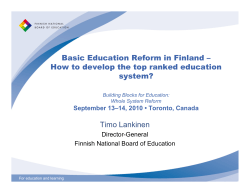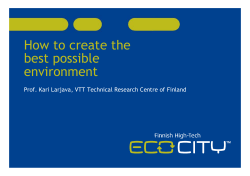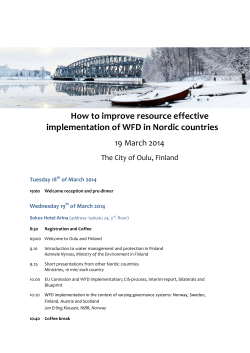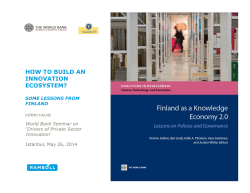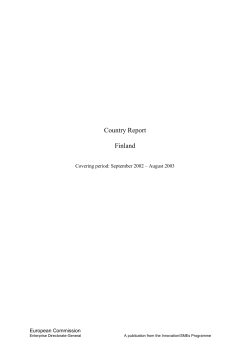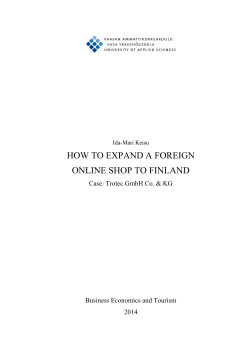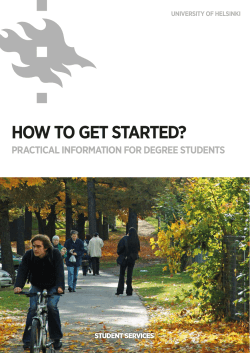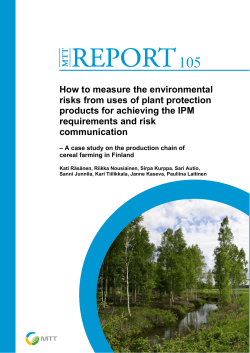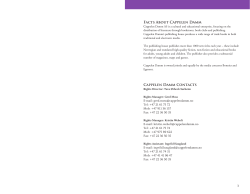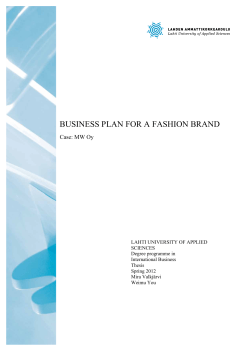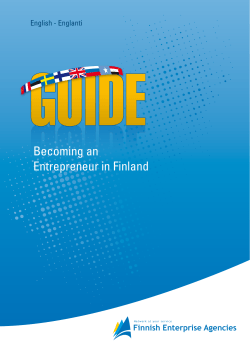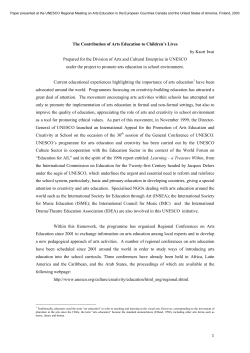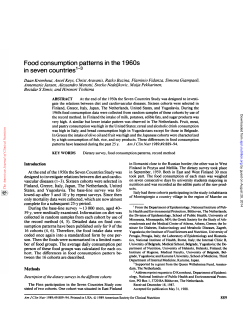
A Model Lesson Finland Shows Us What Equal Opportunity Looks Like
A Model Lesson Finland Shows Us What Equal Opportunity Looks Like By Pasi Sahlberg I illustrations by AndrÉ da Loba nternational indicators show that Finland has one of the most educated citizenries in the world, provides educational opportunities in an egalitarian manner, and makes efficient use of resources. But at the beginning of the 1990s, education in Finland was nothing special in international terms. The performance of Finnish students on international assessments was close to overall averages, except in reading, where Finnish students did better than most of their peers in other countries. The unexpected Pasi Sahlberg is the director general of the Centre for International Mobility and Cooperation in Helsinki, Finland, and an adjunct professor at the University of Helsinki and the University of Oulu. He has been a teacher and teacher educator, as well as an education specialist for the World Bank in Washington, DC, and the European Commission in Turin, Italy. He is a member of the board of directors of the ASCD. This article is adapted with permission from his new book Finnish Lessons: What Can the World Learn from Educational Change in Finland? ©2011 by Teachers College, Columbia University. All rights reserved. 20 AMERICAN EDUCATOR | SPRING 2012 and jarring recession of that time period brought Finland to the edge of a financial breakdown. Bold and immediate measures were necessary to fix national fiscal imbalances and revive the foreign trade that disappeared with the collapse of the Soviet Union in 1990. Today, there are countries around the world where education leaders find their own educational systems in a situation very similar to that of Finland in 1990. The United States, England, Sweden, Norway, and France, just to mention a few, are among those where public education is increasingly challenged because of endemic failure to provide adequate learning opportunities to all children. The story of educational change in Finland brings hope to all those worried about whether improving their educational systems is at all possible. Finland’s system is unique because it has progressed from mediocrity to being a model and “strong performer” over the past three decades. Finland is special also because it has been able to create an educational system where students learn well and where equitable education has translated into little variation in student performance between schools in different parts of the country. This internationally rare status has been achieved using reasonable financial resources and less effort than other reform efforts. The equitable Finnish education system is a result of systematic attention to social justice and early intervention to help those with special needs, and close interplay between education and other sectors—particularly health and social sectors—in Finnish society. It is not only that the education system functions well in Finland, but that it is part of a well-functioning democratic welfare state. Complimentary school lunches, comprehensive welfare services, and early support to those in need have been made available to all children in all Finnish schools—free of charge. Every child has, by law, a right to these welfare services in his or her school. Therefore, attempts to explain the success of the education system in Finland should be put in the wider context and seen as a part of the overall function of democratic civil society. Economists have been interested in finding out why Finland has been able to become the most competitive economy in the world. Educators are trying to figure out the secret of high educational performance of Finland. The quality of a nation or its parts is rarely a result of any single factor. The entire society needs to perform satisfactorily. For example, in terms of income equality, Finland has been among the most equitable countries in the world, together with other Nordic countries, but income inequality has increased in Finland during the last two decades. Increasing inequality is often related to growing social problems,* such as more prevalent violence, diminishing social trust, worsening child well-being, increasing poverty, and declining educational attainment.1 Therefore, the challenge for Finland is not to try to maintain high student performance, but to strive to keep the country an equal society and maintain its leading position as having the most equitable education system in the world. In this article, and in the book from which it is drawn (see page 26), I briefly explain how Finland developed that system and explore a few practices that are essential to its equitable outcomes. From Mediocrity to Excellence and Equity The story of Finland is a story of survival. Being a relatively small nation situated between much larger powers of the East and the West has taught Finns to accept existing realities and take chances with available opportunities. Diplomacy, cooperation, problem solving, and seeking consensus have become hallmarks of contemporary Finnish culture. These traits all play an important part in building an educational system that has enjoyed global attention due to its equitable distribution of good teaching and learning throughout the nation. Most important, Finland had fought for its freedom and survived. External threats experienced during and after World War II united Finns, who still felt the wounds of their 1918 civil war. The post–World War II era was one of political instability and economic transformation, but it also gave rise to new social ideas and social policies—in particular the idea of equal educational opportunities. It is difficult to understand why education has become one of the trademarks of Finland without examining these post–World War II *To read more about the effects of income inequality, see the Spring 2011 issue of American Educator at www.aft.org/pdfs/americaneducator/spring2011/Wilkinson.pdf. political and social developments. History is often easier to understand when it is segmented into periods or phases of development, and the recent history of Finland is no exception. Although there are many ways to recount Finland’s history, in this case it is helpful to illustrate congruencies between the development of Finland’s education system, and three stages of economic development following World War II: • Enhancing equal opportunities for education by way of transition from a northern agricultural nation to an industrialized society (1945–1970); • Creating a public comprehensive school system by way of a Nordic welfare society with a growing service sector and increasing levels of technology and technological innovation (1965–1990); • Improving the quality of basic education and expanding higher education in keeping with Finland’s new identity as a high-tech knowledge-based economy (1985–present).2 School lunches, welfare services, and early support to those in need have been made available to all children in all Finnish schools—free of charge. The end of World War II prompted such radical changes to Finnish political, social, and economic structures that immediate changes to education and other social institutions were required. Indeed, education soon became the main vehicle of social and economic transformation in the postwar era. In 1950, educational opportunities in Finland were unequal in the sense that only those living in towns or larger municipalities had access to grammar or middle schools. Most young people left school after six or seven years of formal basic education. Where private grammar schools were available, pupils could apply to enroll in them after four, five, or six years of state-run basic school, but such opportunities were limited. In 1950, for example, just 27 percent of 11-year-old Finns enrolled in grammar schools consisting of a five-year middle school and a three-year high school. An alternative educational path after the compulsory seven years of basic education was two or three years of study in one of the so-called “civic schools” (which had a vocational focus), offered by most Finnish municipalities. This basic education could be followed by vocational training and technical education, but only in larger municipalities and towns that housed these institutions. In the early years after Finland’s independence, teaching in primary schools was formal, teacher-centered, and more focused on moral than cognitive development. Three dominant themes AMERICAN EDUCATOR | SPRING 2012 21 in Finnish national education policy between 1945 and 1970 would come to change this traditional model: • The structure of the education system would be changed to establish a public, comprehensive school system that would provide access to better and more education for all; • The form and content of curricula would focus on development of individual, holistic personalities of children; and • Teacher education would be modernized to respond to needs arising from these developments. The future dream of Finland was built on knowledge and skills; thus, education was seen as a foundation for establishing the future.3 The first two decades after World War II were politically turbulent in Finland. It was difficult for many politicians to accept that the educational architecture of the day, which maintained and actually more deeply entrenched inequality in Finnish society, would be unable in the long run to ensure that Finland would achieve its goal of becoming a knowledge society. Some predicted a gloomy future for Finland if the new ideas related to common unified public school for all were approved: declining level of knowledge, waste of existing national talent, and Finland, as a nation, being left behind in the international economic race. Nonetheless, in the 1960s, the social policy climate had consolidated the values of equality and social justice across the social classes of Finnish society. The expenditures incurred by the ideal of a welfare state were seen, as argued by a prominent Finnish political scientist, Professor Pekka Kuusi, as an investment in increasing productivity.4 The new comprehensive school system— or peruskoulu—was poised for implementation in 1972. According to the plan, a wave of reform was to begin in the northern regions of Finland and reach the southern urban areas by 1978. A fundamental belief from the old structure was that everyone cannot learn everything, that talent in society is not evenly distributed in terms of one’s ability to be educated. It was important that the new peruskoulu shed these beliefs, and thus help to build a more socially just society with higher education levels for all. The central idea of peruskoulu was to merge existing grammar schools, civic schools, and primary schools into a comprehensive nine-year municipal school. This meant that the placement of students after four years of primary education into grammar and civic streams would come to an end. All students, regardless of their domicile, socioeconomic background, or interests would enroll in the same nine-year basic schools governed by local education authorities. Critics of the new system maintained that it was not possible to have the same educational expectations of children coming from very different social and intellectual circumstances, and that overall education attainment would have to be adjusted downward to accommodate less-talented students. Fortunately, those critics did not prevail. As planned, the wave of implementation began in the northern parts of Finland in 1972. The last of the southern municipalities shifted to the new comprehensive school system in 1979. The National Curriculum for the Comprehensive School steered the content, organization, and pace of teaching throughout the country. For the first several years, while the structure of the comprehensive school was similar for all students, the national curriculum provided schools with tools to differentiate instruction for different ability groups and personalities. Foreign lan- 22 AMERICAN EDUCATOR | SPRING 2012 guages and mathematics teaching, for example, were arranged in a way that offered students options for three levels of study in grades 7 to 9: basic, middle, and advanced. In 1985, ability grouping was abolished in all school subjects; since then, all students have studied according to the same curricula and syllabi. Comprehensive school reform triggered the development of three particular aspects in the Finnish education system that would later prove to be instrumental in creating a well-performing education system. First, bringing together a wide variety of students, often with very different life circumstances and aspirations, to learn in the same schools and classes required a fundamentally new approach to teaching and learning. The equal opportunity principle insisted that all students be offered a fair chance to be successful and enjoy learning. From early on, it was understood that the education of pupils with special needs would only be successful if learning difficulties and other individual deficits were identified early and promptly treated. Special education quickly became an integral part of school curricula, and all municipalities and schools soon housed experts trained to support special needs pupils. Second, career guidance and counseling became a compulsory part of the comprehensive school curriculum in all schools. It was assumed at the time that if all pupils remained in the same school until the end of their compulsory education, they would need systematic counseling on their options after completing basic school. Career guidance was intended to minimize the possibility that students would make inappropriate choices regarding their futures. In principle, students had three options: continue general education in upper secondary general school (which about 51 percent of students do), go on to vocational upper secondary school (which about 42 percent of students do), or find employment. Both types of upper secondary education offered several internal options. Career guidance and counseling soon became a cornerstone of both lower and upper secondary education, and have been an important factor in explaining low grade repetition and dropout rates in Finland.5 Career guidance has also served as a bridge between formal education and the world of work. As part of the overall career guidance curriculum, each student in peruskoulu spends at least two weeks in a selected workplace. Third, the new peruskoulu required that teachers who were working in very different schools, namely the academic grammar schools and the work-oriented civic schools, had to begin to work in the same schools with students with diverse abilities. Compre- hensive school reform was not just an organizational change, but a new philosophy of education for Finnish schools.6 This philosophy included the beliefs that all pupils can learn if they are given proper opportunities and support, that understanding of and learning through human diversity is an important educational goal, and that schools should function as small-scale democracies, just as John Dewey had insisted decades before.7 Peruskoulu therefore required that teachers employ alternative instructional methods, design learning environments that enable differentiated learning for different pupils, and perceive teaching as a high profession. These expectations led to wide-scale teacher education reform in 1979, including a new law on teacher education, with an emphasis on professional development and research-based teacher education. It is noteworthy that in Finland, all education after the nineyear peruskoulu is noncompulsory. Rather than making upper secondary education compulsory, Finnish education policies have relied on developing equal opportunities for all to participate in upper secondary education as a matter of individual choice, while at the same time creating incentives (such as flexible study schedules and tuition-free higher education) for young people to stay on in the education system after completion of compulsory education. All students in upper secondary school have personalized learning plans that are not tied to age groups or classes, so some students take more time to complete their studies than others. Education policies that have driven Finnish reforms since 1970 have prioritized creating equal opportunities, raising quality, and increasing participation within all educational levels across Finnish society. As a result, more than 99 percent of the age cohort successfully completes compulsory peruskoulu, about 95 percent continue their education in upper secondary schools, and an additional 3 percent enroll in a voluntary 10th grade of peruskoulu. Of those starting upper secondary school, 93 percent eventually receive their school leaving certification, providing access to higher education.8 Central to this effort to create equal opportunities are the principles of education and care that are typical of Finnish schools today. For example, schools are encouraged to maintain strong support systems for teaching and learning—nutritious, free school meals for all pupils, health services, psychological counseling, and student guidance are normal practices in every school. Another strong element of the education system in Finland is built-in networks of schools and communities of teachers in municipalities, and their seamless connection to other social services in society. Unlike many other contemporary systems of education, the Finnish system has not been infected by market-based competition and high-stakes testing policies. The main reason is that the education community in Finland has remained unconvinced that competition and choice with more standardized testing than students evidently require would be good for schools. The ultimate success of a high-stakes testing policy is determined by whether it positively affects student learning, not whether it increases student scores on a particular test.9 If student learning remains unaffected, or if testing leads to biased teaching, the validity of such highstakes tests must be questioned. Finnish education authorities and especially teachers have not been convinced that frequent external census-based testing and stronger accountability would be beneficial to students and their learning. Education policies are necessarily intertwined with other social policies, and with the overall political culture of a nation. The key success factor in Finland’s development of a well-performing knowledge economy with good governance and a respected education system has been its ability to reach broad consensus on most major issues concerning future directions for Finland as a nation. Finland seems particularly successful in implementing and maintaining the policies and practices that constitute sustainable leadership and change.10 Education in Finland is seen as a public good and therefore has a strong nationbuilding function. The success of a high-stakes testing policy is determined by whether it positively affects student learning, not whether it increases student scores on a particular test. Education policies designed to raise student achievement in Finland have put a strong accent on teaching and learning by encouraging schools to craft optimal learning environments and establish instructional content that will best help students to reach the general goals of schooling. It was assumed very early in Finland’s reform process that instruction is the key element that makes a difference in what students learn in school, not standards, assessment, or alternative instructional programs. As the level of teacher professionalism gradually increased in schools during the 1990s, the prevalence of effective teaching methods and pedagogically focused school designs increased. A new flexibility within the Finnish education system enabled schools to learn from one another, and thus make best practices universal by adopting innovative approaches to organize schooling. It also encouraged teachers and schools to continue to expand their repertoires of teaching methods, and to individualize teaching in order to meet the needs of all students. As a result, Finnish education today offers a compelling model because of its high quality and equitable student learning. As the figure on page 25 shows, Finland, Canada, Japan, and Korea have education systems that rate highly in quality and equity; they produce consistent learning results regardless of students’ socioeconomic status. Intervening Early and Often Equity in education is an important feature in Nordic welfare states. It means more than just opening access to an equal education for all. Equity in education is a principle that aims at guaranteeing high-quality education for all in different places and circumstances. In the Finnish context, equity is about having a socially fair and inclusive education system that is based on AMERICAN EDUCATOR | SPRING 2012 23 equality of educational opportunities. As a result of the comprehensive school reform of the 1970s, education opportunities for good-quality learning have spread rather evenly across Finland. There was a visible achievement gap among young adults at the start of comprehensive school in the early 1970s due to very different educational orientations associated with the old system. This knowledge gap strongly corresponded with the socioeconomic divide within Finnish society at that time. After abolishing streaming in the mid-1980s and making learning expectations the same for all students, the achievement gap between low and high achievers began to decrease. Clear evidence of more equitable learning outcomes came in 2000 from the first Programme for International Student Assessment (PISA) survey by the Organization for Economic Cooperation and Development (OECD). In that study, Fin- A consistent focus on equity and shared responsibility—not choice and competition—can lead to an education system where all children learn better. land had the smallest performance variations between schools in reading, mathematics, and science of all OECD nations. A similar trend continued in the 2003 PISA cycle and was even strengthened in the PISA surveys of 2006 and 2009.11 An essential element of the Finnish comprehensive school is systematic attention to those students who have special educational needs. Special education is an important part of education and care in Finland. It refers to designed educational and psychological services within the education sector for those with special needs. The basic idea is that with early recognition of learning difficulties and social and behavioral problems, appropriate professional support can be provided to individuals as early as possible. The aim of special education is to help and support students by giving them equal opportunities to complete school in accordance with their abilities and alongside their peers. There are two main pathways in special education in the Finnish comprehensive school. The first path sees the student included in a regular class and provided with part-time special education in small groups. These groups are led by a special education teacher if the difficulties in learning are not serious. The student may also have an individual learning plan that adjusts the learning goals according to his or her abilities. Students with special educational needs may complete their studies following a regular or an adjusted curriculum. Student assessment is then based on the individual learning plan. The second pathway is to provide permanent special education in a special group or class in the student’s own school or, in some cases, in a separate institution. Transfer to special education in this case requires an official decision that is based on a statement by a psychological, medical, or social welfare professional, with a mandatory parental hearing. In Finland, the transfer decision 24 AMERICAN EDUCATOR | SPRING 2012 to special needs education is made by the school board of the pupil’s municipality of residence, and can be processed rather quickly (within a few months in most cases). In order to promote success in learning, each student in special education has a personalized learning plan that is based on the school curriculum and adjusts educational expectations individually. In the 2009–2010 school year, almost one-third of all students in peruskoulu were enrolled in one of the two alternative forms of special education described above. More than 23 percent of peruskoulu students were in part-time special education that focuses on curing minor dysfunctions in speaking, reading, and writing, or learning difficulties in mathematics or foreign languages. The remaining 8.5 percent of students were permanently transferred to a special education group, class, or institution. The number of students in permanent special education has doubled in the last 10 years; at the same time, the number of special education institutions has declined steadily since the early 1990s. Since those students who are in part-time special education normally vary from one year to another, up to half of those students who complete their compulsory education at the age of 16 have been in special education at some point in their schooling. In other words, it is nothing that special anymore for students. This fact significantly reduces the negative stigma that is often brought on by special education. At the dawn of peruskoulu reform, Finland adopted a strategy of early intervention and prevention to help those individuals who have special educational needs of some kind. This means that possible learning and development deficits are diagnosed and addressed during early childhood development and care, before children enter school. In the early years of primary school, intensive special support, mostly in reading, writing, and arithmetic, is offered to all children who have major or minor special needs. Therefore, the proportion of students in special education in Finland in the early grades of primary school is relatively higher than in most other countries. The number of special needs students in Finland declines by the end of primary school and then slightly increases as students move to subject-based lower secondary school. The reason for the increased need for special support in lower secondary school is that the unified curriculum sets certain expectations for all students, regardless of their abilities or prior learning.* High-equity education in Finland is not a result of educational factors alone. Basic structures of the Finnish welfare state play a crucial role in providing all children and their families with equitable conditions for starting a successful educational path at the age of 7. Early childhood care, voluntary free preschool that is attended by some 98 percent of the age cohort, comprehensive health services, and preventive measures to identify possible learning and development difficulties before children start schooling are accessible to all in Finland. Finnish schools also provide all pupils with free and healthy lunch every day regardless of their home socioeconomic situation. Child poverty is at a very low level, less than 4 percent of the child population (compared with over 20 percent in the United States). In order to prevent children from (Continued on page 26) *The common strategy internationally is to repair problems in primary and lower secondary education as they occur rather than try to prevent them from happening.12 Countries that employ the strategy of repair have an increasing relative number of special needs students throughout primary and lower secondary education. An International Look at Educational Equity In Finland and a handful of other countries, reading performance is strong, but the impact of students’ socioeconomic background is not. The figure below, which is drawn from the Programme for International Student Assessment (PISA) conducted by the Organization for Economic Cooperation and Development (OECD), shows each OECD country’s (1) average reading score among 15 year olds and (2) average impact of students’ socioeconomic backgrounds on their performance. To provide a guide as to each country’s 600 relative standing, the figure is broken into quadrants using the OECD averages. Not surprisingly, many countries’ averages are quite close to the OECD’s averages. So, the figure also shows, as follows, which countries are statistically significantly more equitable, significantly less equitable, or no different than the OECD countries as a whole: than the OECD’s average (indicating greater educational equity). Countries in which the relationship between reading performance and socioeconomic background is stronger than the OECD’s average (indicating less educational equity). Countries in which the relationship between reading performance and socioeconomic background is not statistically significantly different than the OECD’s average. • ■Countries in which the relationship between reading performance and socioeconomic background is weaker –Editors Above-average reading performance Above-average impact of socioeconomic background Above-average reading performance Below-average impact of socioeconomic background 550 Korea Switzerland Denmark Mean reading score New Zealand United Kingdom Sweden United States Poland Belgium Hungary Netherlands Norway Germany OECD average: 493 Japan Australia France 500 Canada Finland Estonia Ireland Portugal Slovenia Greece Iceland Italy Czech Republic Luxembourg Turkey 450 Israel Austria Spain Slovak Republic Mexico 400 Below-average reading performance Above-average impact of socioeconomic background 30 25 20 15 OECD average: 14% Chile Below-average reading performance Below-average impact of socioeconomic background 10 5 0 Percentage of variance in performance explained by the PISA index of economic, social, and cultural status (r-squared × 100) Note: In its report on the 2009 PISA results, the OECD included a version of this figure with 65 OECD and non-OECD countries and regions. The figure shown here draws from the same data, but only shows OECD countries. For the OECD’s version of this figure, and the data it is based on, see Organization for Economic Cooperation and Development, PISA 2009 Results: Overcoming Social Background—Equity in Learning Opportunities and Outcomes, vol. 2 (Paris: OECD, 2010), Figure II.3.3 and Table II.3.2. AMERICAN EDUCATOR | SPRING 2012 25 (Continued from page 24) being ranked according to their educational performance in schools, grade-based assessments are not normally used during the first five years of peruskoulu. It has been an important principle in developing elementary education in Finland that structural elements that cause student failure in schools should be removed. That is why grade retention and overreliance on academic performance have gradually vanished in Finnish schools. Preventing Grade Repetition Grade repetition in the old Finnish school system was not rare in elementary schools, and it was an integral educational principle of grammar school. In some cases, a student repeated the third grade of elementary school in order to improve knowledge and skills required in the grammar school admission test at the end of the fourth grade. At the time of the introduction of the new nine-year school, approximately 12 percent of students in each grammar school grade did not progress from their grade. Up to half of those graduating from upper secondary grammar school repeated one or more grades at some point of their schooling.13 Furthermore, significant numbers of students dropped out of school before completion—often after not being able to progress from one grade to the next. In the old school system, grade repetition was a method of differentiation for teachers. Problems related to retention were well known; being sent back to the same grade with younger students was often demoralizing and rarely made way for the expected academic improvements among students.14 After all, repeating an entire grade was an inefficient way of promoting learning because it did not focus on those parts of the curriculum in which a student needed targeted help. Studying for a second time those subjects that a student had already successfully completed was rarely Finnish Lessons What Can the World Learn from Educational Change in Finland? Reforming schools is a complex and slow process. This book is about how such a process evolved in Finland since World War II. It is the first book written for international readers that tells the story of how Finland created a system praised as much for its equity as for its high quality. Many of the world’s great newspapers and broadcast services—the New York Times, the Washington Post, the Times of London, Le Monde, El Pais, National Public Radio, CNN, NBC, Deutsche Welle, and the BBC—have covered this Finnish educational miracle. Thousands of official delegations have visited Finnish authorities, schools, and communities to learn about what drives excellence in education. Until now, however, this story has not received the book-length treatment necessary for enumerating, linking, and explaining the many players, institutions, and impersonal forces involved. My approach in this book is both personal and academic. It is personal because of my intimate relationship with education in Finland. I was born in northern Finland and raised in a village primary school, as both of my parents were teachers at that school. Most of my childhood memories are in one way or another linked to school. I had the privilege of looking beyond the secrets of the classroom after everybody else was gone, and I found that world rich. It was my home and an enchanted one. It is perhaps no surprise then that I went on to become a teacher. My first position was at a junior high school in Helsinki. I taught mathematics and physics there for seven years. Later, I spent 26 enough time in educational administration and in university teacher education to understand the difference between education in school and out. As a policy analyst for the Organization for Economic Cooperation and Development, an education specialist for the World Bank, and an expert for the European Commission, I gained the global perspective necessary for a deeper appreciation of Finland’s distinct place in education. As this book illustrates, there is no single reason why any educational system succeeds or fails. Instead, there is a network of interrelated factors—educational, political, and cultural—that function differently in different situations. I would, however, like to cite an important element of Finnish educational policies since the early 1970s that appears to transcend cultures: an inspiring vision of what good public education should be. Finland has been particularly committed to building a good publicly financed and locally governed basic school for every child. This common educational goal became so deeply rooted in politics and public services in Finland that it survived opposing political governments and ministries unharmed and intact. Since the introduction of peruskoulu (the nine years of basic schooling with a common curriculum for all children) in the early 1970s, there have been 20 governments and nearly 30 different ministers of education in charge of educational reforms in AMERICAN EDUCATOR | SPRING 2012 Finland. So strong has this commitment to common basic school for all been that some call it the “Finnish Dream.” The size of Finland’s population and relative homogeneity of its society obviously make many aspects of setting education policies and implementing reforms easier than in larger, more diverse jurisdictions. But these factors alone don’t explain all the progress and achievements in education that are described in this book, and they should not stop us from learning from one another as we strive to improve education for all students. Finland is, however, very unique among nations in terms of its values, cultural determinants, and social cohesion within society. Fairness, honesty, and social justice are deeply rooted in the Finnish way of life. People have a strong sense of shared responsibility not only for their own lives, but also for those of others. Fostering the well-being of children starts before they are born and continues until they reach adulthood. Daycare is a right of all children before they start school at age 7, and public health services are easily accessible to all during childhood. Education in Finland is widely seen as a public good and is therefore protected as a basic human right to all in the Constitution. –P.S. To follow the latest developments in Finnish education and hear news about events related to Finnish Lessons, be sure to visit www.finnish lessons.com. stimulating for students or their teachers. Students were sent to the same class without a plan to specify the areas of improvement, let alone the methods of achieving most effectively the required levels of knowledge and skills. In the early days of comprehensive school reform, grade repetition was seen as an inadequate and wrong strategy for fixing individual learning or social deficiencies. In the elementary school, grade repeaters who had difficulties in one or two subjects were often labeled as “failing” students who also had behavioral and personality problems. This educational stigma normally had a dramatic negative impact on students and also lowered teachers’ expectations regarding these students’ abilities to learn. Grade repetition created a vicious circle that for many young people cast a negative shadow right into adulthood. Educational failure is linked to an individual’s role in society and is character- and every school in Finland. Every child has the right to get personalized support provided early on by trained professionals as part of normal schooling. This special support is arranged in many different ways today. As described earlier, special education in Finland is increasingly organized within general mainstream schooling. Upper secondary schools—both general and vocational— operate using modular curriculum units rather than year-based grades. Thus, grade repetition in its conventional form has vanished from Finnish upper secondary schools. This nonclass structure has also abolished classes in which the same group of students move from one lesson to another and from one grade to the next. In the early 1980s, approximately 15 percent of students repeated a grade at least once. Today, students build their own personalized learning schedules from a menu of courses offered in their schools or by other education institutions. Studying in upper secondary school is therefore flexible, and selected courses can be completed at a different pace depending on the students’ abilities and life situations. Rather than repeating an entire grade, a student only repeats those courses that were not passed satisfactorily. Most students complete upper secondary school in the prescribed time of three years, although some progress faster and some need more time than others. M ized by unfavorable attitudes toward learning and further education. Grade repetition, in most cases, led to increased social inequality rather than helping students to overcome academic and social problems. Peruskoulu quickly changed grade repetition policies and practices. The new comprehensive school did not completely remove the problem of repeating grades, but the number of students who repeated grades in the comprehensive school decreased significantly. Personalized learning and differentiation became basic principles in organizing schooling for students across society. The assumption that all students can achieve common educational goals if learning is organized according to each student’s characteristics and needs became another foundation. Retention and ability grouping were clearly against these ideals. Different students have to learn to work and study together in the same class. Diversity of students’ personalities, abilities, and orientations has to be taken into account in crafting learning environments and choosing pedagogical methods in schools. This turned out to be one of the most demanding professional challenges for teachers. Even today, schools are searching for an optimal educational and economic solution for Finland’s rapidly increasing diversity.* Minimizing grade repetition has been possible primarily because special education has become an integral part of each ichael Fullan, a Canadian educational change scholar, speaks about “drivers of change,” such as education policy or strategy levers, which have the best chances of driving intended change in education systems. “In the rush to move forward,” writes Fullan, “leaders, especially from countries that have not been progressing, tend to choose the wrong drivers.”15 “Wrong drivers” include accountability (vs. professionalism), individual teacher quality (vs. collegiality), technology (vs. pedagogy), and fragmented strategies (vs. systems thinking). The Finnish experience shows that a consistent focus on equity and shared responsibility—not choice and competition—can lead to an education system where all children learn better than they did before. Understanding Finnish educational success needs to include an awareness of sociocultural, political, and economic factors. Indeed, there is more to the picture than meets the eye. An external OECD expert review team that visited Finland observed that “it is hard to imagine how Finland’s educational success could be achieved or maintained without reference to the nation’s broader and commonly accepted system of distinctive social values that more individualistic and inequitable societies may find it difficult to accept.”16 Another visiting OECD team confirmed that the Finnish approaches to equitable schooling rely on multiple and reinforcing forms of intervention with support that teachers can get from others, including special education teachers and classroom assistants.17 Furthermore, Finland has shown that educational change should be systematic and coherent, in contrast with the current haphazard intervention efforts of many other countries. (Continued on page 40) *It is true that Finland long remained ethnically homogeneous. However, since it joined the European Union in 1995, cultural and ethnic diversification has been faster than in other European Union countries, especially in larger cities’ districts and schools, where first- and second-generation immigrants account for one-quarter of the total population. AMERICAN EDUCATOR | SPRING 2012 27 Finland (Continued from page 27) The conclusion was that “developing the capacities of schools is much more important than testing the hell out of students, and that some nonschool policies associated with the welfare state are also necessary.”18 Scores of news articles on Finnish education have concluded that trust, teacher professionalism, and taking care of those with special needs are the factors that distinguish Finnish schools from most others. Importing a specific aspect of Finland’s education system, whether it is curricula, teacher training, special education, or school leadership, is probably of little value to those aiming to improve their own education systems. The Finnish welfare system guarantees all children the safety, health, nutrition, and moral support that they need to learn well in school. One lesson from Finland is, therefore, that successful change and good educational performance often require improvements in social, employment, and economic sectors. As described by theoretical biologist Stuart Kauffman,19 separate elements of a complex system rarely function adequately in isolation from their original system in a new environment. ☐ Endnotes 1. Richard Wilkinson and Kate Pickett, The Spirit Level: Why More Equal Societies Almost Always Do Better (New York: Allen Lane, 2009). 2. Pasi Sahlberg, “Rethinking Accountability for a Knowledge Society,” Journal of Educational Change 11, no. 1 (2010): 45–61. 3. Erkki Aho, Kari Pitkänen, and Pasi Sahlberg, Policy Development and Reform Principles of Basic and Secondary Education in Finland since 1968 (Washington, DC: World Bank, 2006). 4. Pekka Kuusi, 60-luvun sosiaalipolitiikka [Social Politics of the 1960s] (Porvoo, Finland: WSOY, 1961). 5. Jouni Välijärvi and Pasi Sahlberg, “Should ‘Failing’ Students Repeat a Grade? Retrospective Response from Finland,” Journal of Educational Change 9, no. 4 (2008): 385–389. 6. Jouni Välijärvi, Pekka Kupari, Pirjo Linnakylä, Pasi Reinikainen, Sari Sulkunen, Jukka Törnroos, and Inga Arffman, The Finnish Success in PISA—and Some Reasons Behind It 2 (Jyväskylä, Finland: University of Jyväskylä, 2007); and Jarkko Hautamäki, Elina Harjunen, Airi Hautamäki, Tommi Karjalainen, Sirkku Kupiainen, Seppo Laaksonen, Jari Lavonen, Erkki Pehkonen, Pekka Rantanen, and Patrik Scheinin, with Irmeli Halinen and Ritva Jakku-Sihvonen, Pisa06 Finland: Analyses, Reflections, and Explanations (Helsinki, Finland: Ministry of Education, 2008). 7. John Dewey, Democracy and Education: An Introduction to the Philosophy of Education (New York: Macmillan, 1916). 8. Statistics Finland, “Education” (Helsinki, Finland), www.stat. fi/til/kou_en.html. 9. Audrey L. Amrein and David C. Berliner, “High-Stakes Testing, Uncertainty, and Student Learning,” Education Policy Analysis Archives 10, no. 18 (2002), http://epaa.asu.edu/ojs/ article/view/297/423. 10. Andy Hargreaves and Dean Fink, Sustainable Leadership (San Francisco: Jossey-Bass, 2006). 11. Organization for Economic Cooperation and Development, Knowledge and Skills for Life: First Results from PISA 2000 (Paris: OECD, 2001); Organization for Economic Cooperation and Development, Learning for Tomorrow’s World: First Results from PISA 2003 (Paris: OECD, 2004); Organization for Economic Cooperation and Development, PISA 2006: Science Competencies for Tomorrow’s World, vol. 1 (Paris: OECD, 2007); and Organization for Economic Cooperation and Development, PISA 2009 Results: What Students Know and Can Do—Student Performance in Reading, Mathematics and Science, vol. 1 (Paris: OECD, 2010). 12. Tiina Itkonen and Markku Jahnukainen, “An Analysis of Accountability Policies in Finland and the United States,” International Journal of Disability, Development and Education 54, no. 1 (2007): 5–23. 13. Välijärvi and Sahlberg, “Should ‘Failing’ Students Repeat a Grade?” 14. Jere Brophy, Grade Repetition, Education Policy Series 6 (Paris: International Institute for Educational Planning, 2006); and Shane R. Jimerson, “Meta-Analysis of Grade Retention Research: Implications for Practice in the 21st Century,” School Psychology Review 30, no. 3 (2001): 420–437. 15. Michael Fullan, Choosing the Wrong Drivers for Whole System Reform, Seminar Series Paper No. 204 (East Melbourne, Australia: Centre for Strategic Education, 2011), 5. 16. Andy Hargreaves, Gábor Halász, and Beatriz Pont, “The Finnish Approach to System Leadership,” in Improving School Leadership, Volume 2: Case Studies on System Leadership, ed. Beatriz Pont, Deborah Nusche, and David Hopkins (Paris: Organization for Economic Cooperation and Development, 2008), 92. 17. Organization for Economic Cooperation and Development, Equity in Education Thematic Review: Country Analytical Report, Finland (Paris: OECD, 2005). 18. W. Norton Grubb, “Dynamic Inequality and Intervention: Lessons from a Small Country,” Phi Delta Kappan 89, no. 2 (2007): 112. 19. Stuart Kauffman, At Home in the Universe: The Search for the Laws of Self-Organization and Complexity (Oxford: Oxford University Press, 1995). INTENTIONALLY LEFT BLANK 40 AMERICAN EDUCATOR | SPRING 2012
© Copyright 2025
